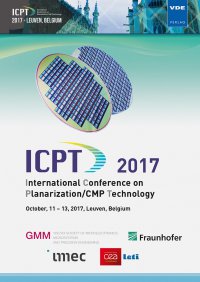Evaluation of Competitive Reaction of Various Cu CMP Slurry Components
Conference: ICPT 2017 - International Conference on Planarization/CMP Technology
10/11/2017 - 10/13/2017 at Leuven, Belgium
Proceedings: ICPT 2017
Pages: 6Language: englishTyp: PDF
Personal VDE Members are entitled to a 10% discount on this title
Authors:
Han, Kwang-Min; Cho, Byoung-Jun; Lee, Jung-Hwan; Ryu, Heon-Yul (Department of Bio-Nano Technology, Hanyang University ERICA, Ansan 15588, Korea)
Shima, Shohei; Hamada, Satomi; Hiyama, Hirokuni (EBARA Corporation, Fujisawa, Kanagawa 251-8502, Japan)
Park, Jin-Goo (Department of Bio-Nano Technology & Department of Materials Science and Chemical Engineering, Hanyang University ERICA, Ansan 15588, Korea)
Abstract:
In this study, the competitive reaction kinetics between H2O2 and benzotriazole (BTA) on PVD Cu were investigated using atomic force microscope (AFM), microfluidic system, and electrochemical techniques (open circuit potential (OCP) and potentiodynamic polarization). The static etch rate (SER) of Cu was increased with the addition of 5wt% H2O2 in 0.01M citric acid based slurry but decreased with the addition of BTA. The surface roughness of Cu treated in the BTA and a mixed solution of BTA with H2O2 was not increased as high as in H2O2 solution. The AFM measurement using fluidics system indicates thesignificant retardation of Cu oxide growth in the BTA and H2O2 mixed solution. Analyzing the electrochemical experimental results, it shows that the OCP of Cu was increased when H2O2 was added to the solution. It shows that the Cu oxide cannot be grown on BTA while was grown to as high as 12 nm in H2O2 solution. It was confirmed that the Cu oxide growth was rapid in the absence of BTA. This study presents the growth mechanism of Cu oxide on the Cu surface with and without BTA. Keywords: Cu CMP, Cu corrosion inhibition, BTA, Citric Acid, Hydrogen Peroxide, AFM, Open Circuit Potential, Electrochemical Impedance Spectroscopy, Potentiodynamic Polarization


